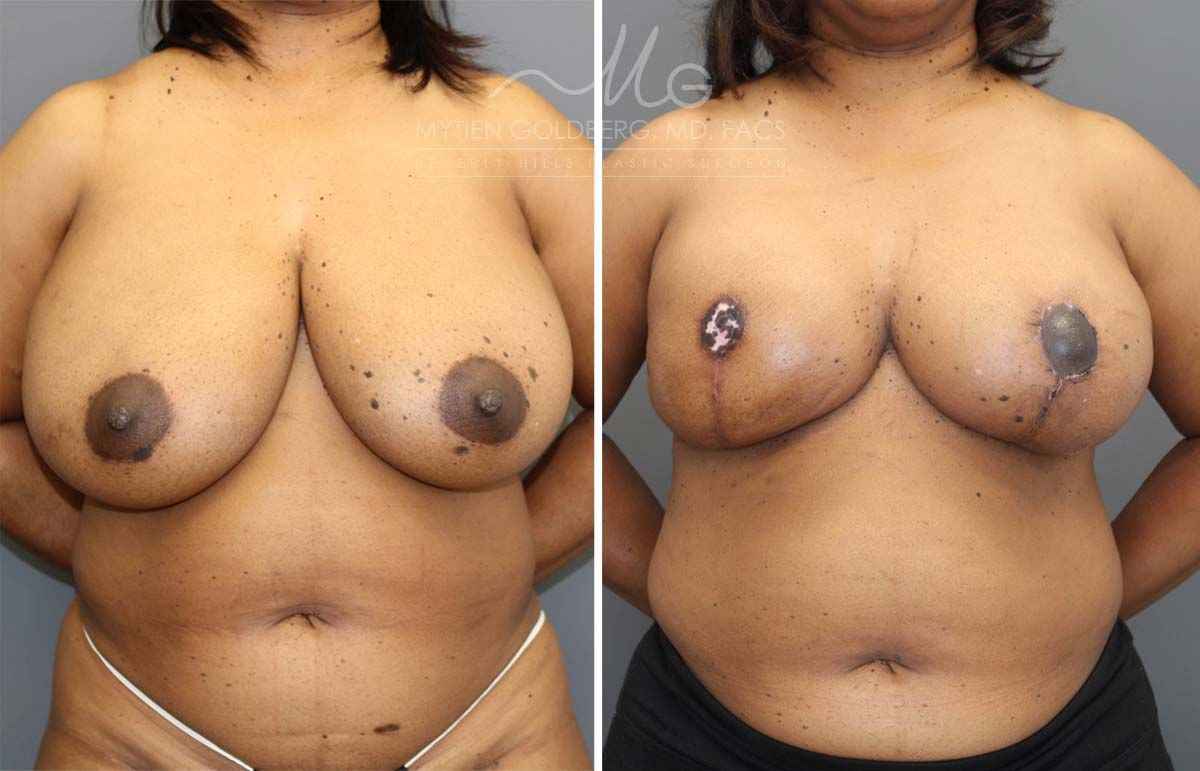2-STAGE IMPLANT-BASED RECONSTRUCTION
THE PREFERRED BREAST RECONSTRUCTION & REVISION SPECIALIST OF BEVERLY HILLS
WHAT IS A 2-STAGE IMPLANT-BASED BREAST RECONSTRUCTION?
A 2-stage implant-based breast reconstruction is the most common type of breast reconstruction being offered in the United States. It is a reconstruction technique that utilizes silicone breast implants as the final product of the reconstruction.
A 2-STAGE IMPLANT-BASED BREAST RECONSTRUCTION
A 2-stage implant-based breast reconstruction is the most common type of breast reconstruction being offered in the United States. It is a reconstruction technique that utilizes silicone breast implants as the final product of the reconstruction. At the first surgery (stage 1), the breast surgeon (surgeon performing the mastectomy procedure) removes the breast tissue and at the same surgery the plastic surgeon will place a tissue expander (balloon) into the breast pocket to create a new breast footprint. The plastic surgeon often also uses mesh products to support the tissue expander. These mesh products are called acellular dermal matrix or ADM or bio-absorable mesh, such as vicryl mesh or Galaflex. Acellular dermal matrix is a biotechnological tissue prepared from human from which the cellular components that cause rejection and inflammation have been removed. The resulting structurally intact tissue matrix provides the biological scaffold necessary for normal tissue in-growth and cellular repopulation.
*Individual Results May Vary
CASE STUDY
Patient is a 53-year-old woman who has right breast cancer. She has invasive lobular carcinoma stage 2. She is a DDD breasts who desires to be smaller. Due to the size of her tumor, she elected to undergo right breast mastectomy.
Her breast reconstructions involves 2 stages.
Stage 1: Right breast mastectomy and immediate reconstruction with tissue expanders and free nipple graft to salvage the nipple and place it in the right location
Stage 2: Right breast tissue expander removal and placement of permanent implant along with left breast reduction for symmetry.
Implant right breast –
Natrelle SCX (extra high profile) 800cc
STAGE 1
Stage 1 is important to place a tissue expander into the breast pocket to preserve the space where the breast tissue was without putting too much undue pressure on the mastectomy skin flap. The patient will then return to the plastic surgeon’s office for a weekly or biweekly inflation of the tissue expander, a process call expansion. During this process, the patient and her plastic surgeon can slowly
Approximately 8 to12 weeks after the first surgery, the plastic surgeon can perform stage 2 of the reconstruction.
STAGE 2
In the second stage (stage 2), the plastic surgeon will remove the tissue expander and replace it with a permanent silicone implants. Often the plastic surgeon will also add minor procedures, such as capsulotomy (opening the capsule), capsulorraphy (tightening of the capsule), fat grafting (fat injection), or removal of excess skin. The most common of these are fat grafting. Fat grafting is injection of fat into the mastectomy skin flap to improve contour and thickness of the skin. It will enhance the softness and contour of the breast reconstructions.
WHO IS A CANDIDATE FOR 2 STAGE IMPLANT- BASED BREAST RECONSTRUCTION?
2-stage implant base breast reconstruction is ideal in patients who desires faster recovery and shorter surgery. It is also ideal in patients with early stage breast cancer that would not require radiation after mastectomy. 2-stage implant base breast reconstruction is also indicated in patients who desires to be much larger than their native breast size. The tissue expander allows for stretching of the breast skin and thus allow for placement of larger implants at the final stage of the reconstruction.
WHAT ARE THE ADVANTAGES OF 2 STAGE IMPLANT BASE BREAST RECONSTRUCTION?
2 STAGE IMPLANT BASE BREAST RECONSTRUCTION OFFER SHORTER DURATION OF SURGERY AND A MUCH FASTER RECOVERY PROCESS WHEN COMPARED TO AUTOLOGOUS TISSUE RECONSTRUCTION. FOR MOST PATIENTS WHO DESIRE QUICKER RECOVERY AND SHORTER SURGERY, IMPLANT BASE RECONSTRUCTION IS A GREAT OPTION.
REQUEST A CONSULTATION
WHAT ARE THE DISADVANTAGES OF 2 STAGE IMPLANT BASE BREAST RECONSTRUCTION?
The disadvantages are multiple surgeries. There are a higher incidence of infection resulting in the removal of the tissue expander or implant and thus loss of breast reconstruction compared to autologous tissue breast reconstruction techniques. Furthermore, it requires multiple visits to your plastic surgeons’ office for tissue expander expansion. Breast implants are not a life device and thus it will require multiple surgical procedures to replace the implant or revision surgery during a patient’s lifetime.
HOW LONG DOES PROCEDURE TAKE?
Normally, stage 1 takes about 3 hours per breast. This includes the removal of the breast (mastectomy) and reconstruction. A bilateral breasts procedure will take about 5 to 6 hours. The patient will be in the hospital overnight for observation. In some facility, the patient may be discharge home on the same day.
Stage 2 surgery is an outpatient surgery. Depending on how many additional procedures are included in stage 2 surgery, it is only about 3 to 4 hours in length.
WHAT IS THE RECOVERY PROCESS?
Once the patient is discharged home, the recovery process is very smooth. Dr. Goldberg ask you to refrain from heavy lifting or pulling for 4 weeks. This allow for the incisions to heal. If a person has a desk job they may return to work sooner.
CALL DR. GOLDBERG’S OFFICE FOR ALL YOUR BREAST RECONSTRUCTION OPTIONS 310-325-0310

